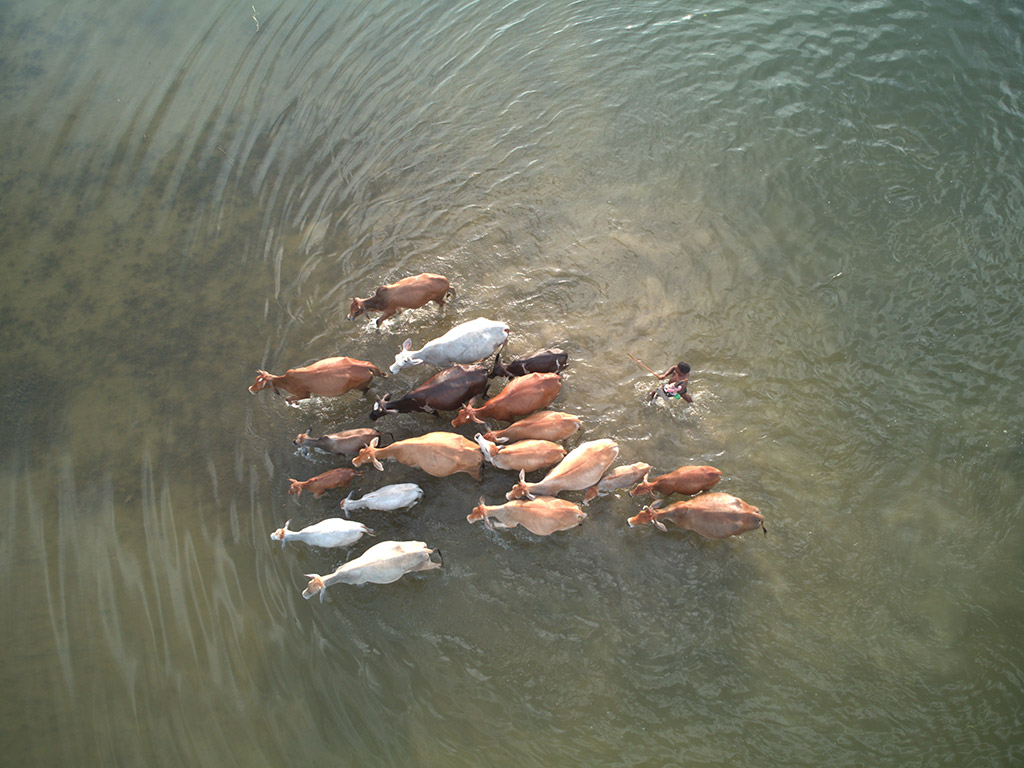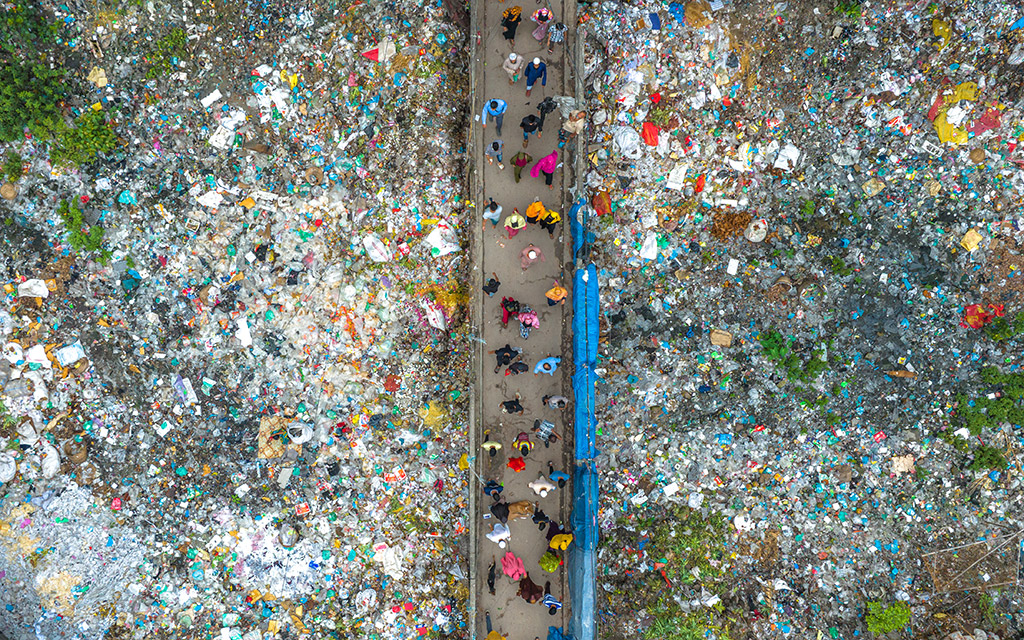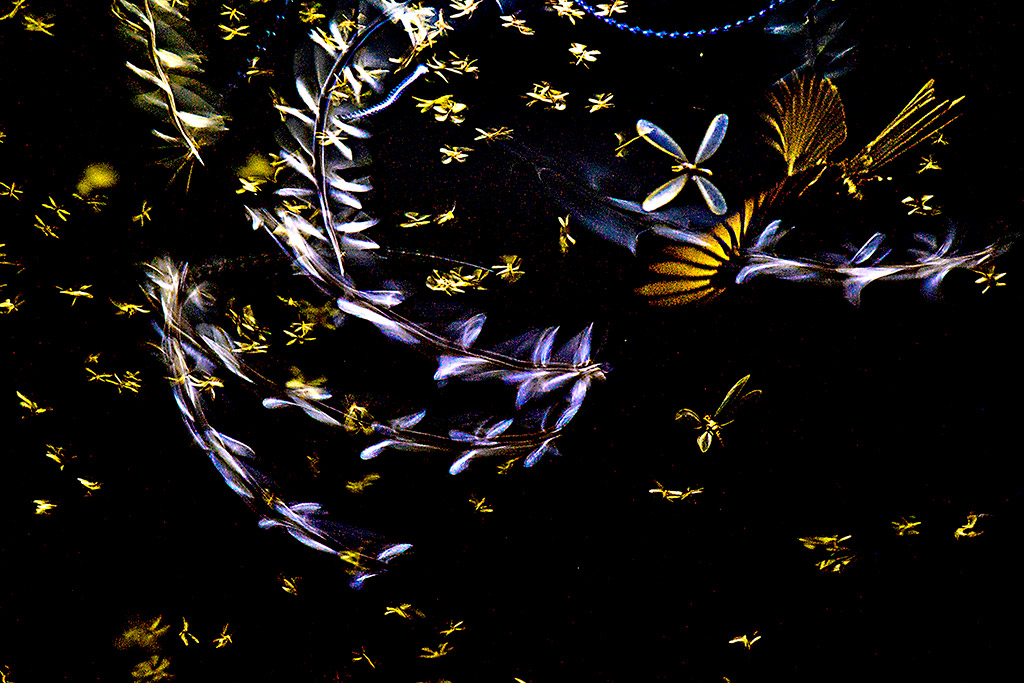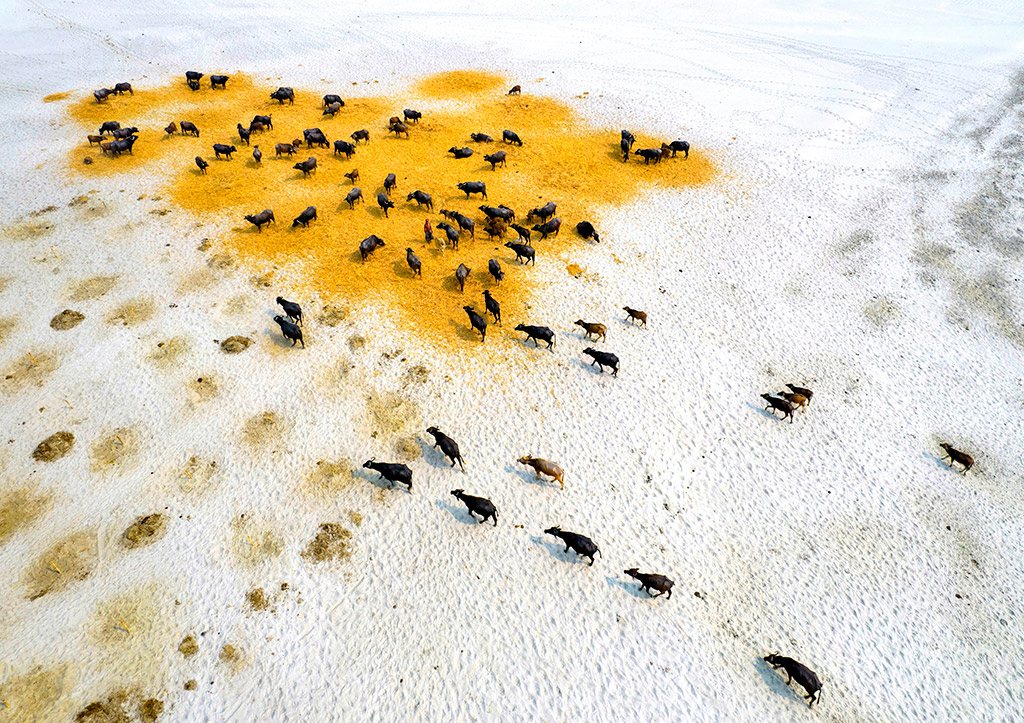Winners of this year’s Environmental Photographer of the Year has been announced! The 16th competition has been won by professional Maurizio di Petro, for his image depicting an innovative insect food experiment at the University of Turin, which assesses the impact of incorporating insect flour into the diets of rainbow trout and chickens to determine its potential as a nutrition source. Nikon’s Young Environmental Photographer of the Year category for photographers 21 and under, has been won by 18-year-old Solayman Hossain with his photo showing a farmer and his cows wading through floodwater.
From Environmental Photographer of the Year:
A termite-snatching drongo, cows wading through flood water, and a coral glowing like a Christmas tree are among the winning photos from this year’s Environmental Photographer of the Year competition.
The competition, launched by CIWEM and WaterBear and presented by Nikon in association with MPB and supported by Arup, attracted thousands of online submissions from over 159 countries. Now in its 16th year, the competition celebrates powerful photography from amateur and professional photographers, providing an international platform to reflect the pressing environmental challenges facing our planet.
This year’s six winners primarily come from climate-vulnerable countries, including Bangladesh, India, and Argentina, with photographers on the front line using photos as a tool to spark climate action and generate awareness.
The competition features two grand title awards and four further award categories:
Environmental Photographer of the Year, Grand title winner: Maurizio di Petro
Maurizio di Petro, professional photographer based in Italy, was recognised for his photo of an innovative insect food experiment at the University of Turin. Led by Professor Laura Gasco, the research project assesses the impact of incorporating insect flour into the diets of rainbow trout and chickens to determine its potential as a nutrition source, particularly as food scarcity increases in line with a growing population.
The Hermetia illucens, or soldier fly, is rich in proteins and a highly sustainable food source, thanks to its minimal water and soil consumption. By feeding on food waste, these insects also contribute to a circular economy. The photo forms part of Maurizio’s “Zero Hunger” series, documenting worldwide food insecurity and the solution presented by insects.
Maurizio di Pietro commented: “My home country of Italy is experiencing a frightening reality: 22% now face food insecurity, and this number is only set to increase as climate change intensifies. Through my photographs, however, I don’t just want to document the problem, but also offer a way forward.
“By photographing experiments of potential new food sources, I hope to break open the closed corridors of academia and raise awareness of this solution around the world. Only by showing a way forward can we inspire people to abandon a doom-drenched view of the world and fight for a better one.”
Jury member, Arati Kumar-Rao, said of the winning photo: “The image encapsulates our dependence on the smallest creatures for survival. Moreover, it is beautifully executed, evoking an almost balletic fragility — apt for the crisis that stares us in the face. It was an image I came back to again and again, and by its nature made me want to know more.”
Nikon’s Young Environmental Photographer of the Year (21 and under): Solayman Hossain
Solayman Hossain, aged 18, nabbed first place in the youth title for his photo showing a farmer and his cows forced to wade through floodwater to find food, after the road became submerged in water. The photo was taken during monsoon season in Kushtia, Bangladesh, in a village close to Solayman’s own.
Solayman said: “I hope my photo will inspire environmental action by showcasing the importance of nature, raising awareness about environmental issues, and encouraging others to take positive steps towards sustainability.”
Jury member, Arati Kumar-Rao, said: “A beautifully composed photograph with a gorgeous color palette. Kudos to our young winner for this well executed drone image.”
“MPB Vision of the Future” category winner: Jahid Apu
Jahid Apu, professional photographer from Bangladesh, took home a category win for his photo of a bridge surrounded by a sea of plastic waste, entitled “A Walk Through Trash”. Bangladesh is one of the top plastic polluted countries, with about 646 tons of plastic collected daily in Dhaka.
Jahid said: “Whenever I walk over this bridge, I always wonder how we can survive with so much plastic. Children are often playing in the garbage, with nearby communities forced to live around this sea of waste.
I want my photo to be a wake-up call, encouraging people around the world to put an end to plastic pollution once and for all. My home country of Bangladesh has been hit especially hard by climate change. As the crisis intensifies, photographers must abandon pretty nature pictures for ones that confront our changing planet and inspire us to protect it.”
“Recovering Nature” Category Winner: Nicolas Marin
Nicolas Marin, a 24-year-old photographer, National Geographic underwater explorer, environmental activist and former professional tennis player based in Argentina, scooped a category win for his photo of a rare luminescent coral. The photo was taken during a night dive in Aruba using a long-exposure technique and an ultraviolet light source.
Documenting and protecting the oceans is a cause close to Nicolas’ heart, as he encounters fishing nets, straws and endless floating garbage while diving.
Nicolas said: “We used specialized dive lights that wouldn’t disturb marine life, and in the darkness, you could only see where the lights were pointed. On this occasion, I witnessed something I had never seen before: a coral glowing like a Christmas tree.
“This photo is important because it showcases the wonder and fragility of marine life and the need to protect it. Bioluminescence is a fascinating natural phenomenon that indicates the health of the ocean. Coral, as one of the foundational pillars of these ecosystems, faces significant challenges due to climate change, pollution, and habitat degradation.
“While there are challenges, there are also solutions underway, such as promoting sustainable fishing practices, establishing marine protected areas, and undertaking efforts to mitigate climate change. For me, corals are hope”.
“Adapting for Tomorrow” category winner: Anirban Dutta
Anirban Dutta, photographer and high-school teacher from West Bengal, secured a win for his multi-exposure image of a cunning drongo using light from an urban petrol pump to catch termites.
Every year before the monsoon season begins, termite species are drawn towards light sources to seek their mates. On this rare occasion Anirban spotted a crafty drongo seizing the opportunity to snatch termites flying around the light source. The drongo’s presence at the urban petrol pump suggests waning food sources in the wild, and indicates how species are adapting to a changing world.
Anirban Dutta said: “I always want to photograph all the amazing, magical, unknown and unseen phenomena of nature. I had to work every evening for two months to achieve this dream-like shot.
In this image I have taken a total of three shots: the first is of the black drongo, the second is of the yellow coloured termites flying in high shutter speed, and the last photo I used slow shutter in tungsten white balance mode.”
“Keeping 1.5 Alive” category winner: Shafiul Islam
Shafiul Islam, Bangladesh-based professional photographer, scored a win for his photo of buffaloes scouring parched grasslands for food during a drought, in Gaibandha, Northern Bangladesh.
Northern and western Bangladesh, comprising 22 districts, has faced ongoing drought, affecting herders who rely on river grasslands to raise buffaloes. The prolonged dry spell has depleted pastures, causing food and water shortages for the buffaloes. To cope, herdsmen provide dry hay as an alternative to the scarce grass.
Shafiul Islam said: “It was challenging to get the photo with the right exposure in the bright sunlight on the white sand. A picture is worth a thousand words. Photography is an art that can be easily understood by people of any age and language. I hope my winning photo, along with the other finalist photographs, will raise awareness about climate change in the whole world.”
This year’s competition proceedings again included an ethics panel, ensuring accountability and transparency in photo selection. The panel, consisting of ethics experts in the fields of journalism and photography, assisted with photo selections around questions of consent, permits, and ethical representation of people and wildlife.
This year’s jury members include Arati Kumar-Rao, National Geographic explorer and photographer; Mattias Klum, acclaimed photographer, author and Nikon ambassador; Matilde Gattoni, award-winning environmental and social photographer.
Sam Sutaria, CEO at WaterBear, and competition partner, added: “Facts and statistics can make climate change seem distant, but these photos bring the reality of the crisis up close, urging us to take action.
“Many of these photos are taken by photographers from places bearing the brunt of a climate catastrophe they didn’t create. By showing us a world so wonderfully alive, yet so fragile, these photos serve as a powerful wake-up call. They should also inspire hope: if we can document climate change so creatively, we should be assured of our ability to tackle it too.”
Bushra Hussain, President, CIWEM commented: “The submissions received this year managed to freeze in a single moment the many faces of our planet and the survival of all that dwell here. The winning submissions are startling and thought provoking and we urge you to take a look and feel the story behind each photo.”
Julian Harvie, Marketing Director, Nikon Northern Europe commented: “In our third year of presenting the Environmental Photographer of the Year Award, we continue to be awestruck by the arresting quality of the images submitted, and moved by the insight they offer us about the world in which we live. As a brand, we have been devoted to empowering creators for more than a century, whether they’re among the best in the world or just starting out. It is extra special, therefore, to sponsor the Young Environmental Photographer of the Year Award once again, and to bear witness to the extraordinary imagery created by this category.”
Rachel Thompson, VP of Sustainability, MPB commented: “We are passionate about visual storytelling and its power to inspire change, with sustainability and the environment at the core of MPB’s own purposeful mission, so we are delighted to have sponsored the, “Vision of the Future” category. The Environmental Photographer of the year competition is a great platform for photographers to showcase their skills, tell compelling stories, and shine a spotlight on important issues. This year’s moving entries have highlighted the range and depth of complexities our future holds if we don’t all take action, and we were particularly captivated by the winning image, which reinforces the urgency.”
Richard Spooner, Global Marketing & Communications Leader for Water, Arup commented: “Photography remains one of the most powerful and evocative storytelling media, transcending cultural and language boundaries. Arup is proud to continue its long-standing association with the Environmental Photographer of the Year competition to help share these important stories. The winning images across each of the categories serve to highlight the many ways in which elements of nature are connected, in turn inspiring positive human action to help shape a better world for everyone.”
To learn more about The Environmental Photographer of the Year winners, visit www.epoty.org.
Please see www.epoty.org for the competition’s ethics statement and more information about the ethics panel.
See more competitions to enter.
- APOY Action winners announced!
- CEWE Photo Awards 2023 winner suspended for staged photo
- Sebastião Salgado honoured in Sony Awards
Follow AP on Facebook, Twitter, Instagram, YouTube and TikTok.














